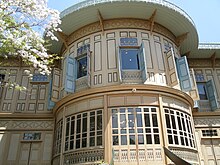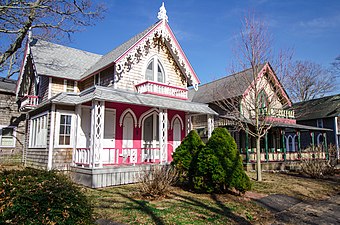
Augustus Welby Northmore Pugin was an English architect, designer, artist and critic with French and Swiss origins. He is principally remembered for his pioneering role in the Gothic Revival style of architecture. His work culminated in designing the interior of the Palace of Westminster in Westminster, London, and its renowned clock tower, the Elizabeth Tower, which houses the bell known as Big Ben. Pugin designed many churches in England, and some in Ireland and Australia. He was the son of Auguste Pugin, and the father of Edward Welby Pugin and Peter Paul Pugin, who continued his architectural firm as Pugin & Pugin.

The Eastlake movement was a nineteenth-century architectural and household design reform movement started by British architect and writer Charles Eastlake (1836–1906). The movement is generally considered part of the late Victorian period in terms of broad antique furniture designations. In architecture the Eastlake style or Eastlake architecture is part of the Queen Anne style of Victorian architecture.

Uttaradit is one of Thailand's seventy-six provinces (changwat). It lies in upper northern Thailand. Neighboring provinces are Phitsanulok, Sukhothai, Phrae and Nan. To the east it borders Xaignabouli of Laos. Uttaradit is 488 km north of Bangkok, and 238 km southeast of Chiang Mai.

Victorian architecture is a series of architectural revival styles in the mid-to-late 19th century. Victorian refers to the reign of Queen Victoria (1837–1901), called the Victorian era, during which period the styles known as Victorian were used in construction. However, many elements of what is typically termed "Victorian" architecture did not become popular until later in Victoria's reign, roughly from 1850 and later. The styles often included interpretations and eclectic revivals of historic styles (see Historicism). The name represents the British and French custom of naming architectural styles for a reigning monarch. Within this naming and classification scheme, it followed Georgian architecture and later Regency architecture and was succeeded by Edwardian architecture.
Fretwork is an interlaced decorative design that is either carved in low relief on a solid background, or cut out with a fretsaw, coping saw, jigsaw or scroll saw. Most fretwork patterns are geometric in design. The materials most commonly used are wood and metal. Fretwork is used to adorn furniture and musical instruments. The term is also used for tracery on glazed windows and doors. Fretwork is also used to adorn/decorate architecture, where specific elements of decor are named according to their use such as eave bracket, gable fretwork or baluster fretwork, which may be of metal, especially cast iron or aluminum. Installing elaborate wooden fretworks on residential buildings, known as gingerbread trims, became popular in North America in the late 19th century.

Lampang, also called Nakhon Lampang to differentiate from Lampang province, is the third largest city in northern Thailand and capital of Lampang province and the Mueang Lampang district. Traditional names for Lampang include Wiang Lakon and Khelang Nakhon. The city is a trading and transportation center. Lampang lies 601 km (373 mi) north of Bangkok and 101 km (63 mi) southeast of Chiang Mai.

The Italianate style was a distinct 19th-century phase in the history of Classical architecture. Like Palladianism and Neoclassicism, the Italianate style combined its inspiration from the models and architectural vocabulary of 16th-century Italian Renaissance architecture with picturesque aesthetics. The resulting style of architecture was essentially of its own time. "The backward look transforms its object," Siegfried Giedion wrote of historicist architectural styles; "every spectator at every period—at every moment, indeed—inevitably transforms the past according to his own nature."

Phrae is a town and capital of Phrae Province and Mueang Phrae district. It is located in Northern Thailand on the east bank of the Yom river, 555 km north of Bangkok by road.

The Stick style was a late-19th-century American architectural style, transitional between the Carpenter Gothic style of the mid-19th century, and the Queen Anne style that it had evolved into by the 1890s. It is named after its use of linear "stickwork" on the outside walls to mimic an exposed half-timbered frame.

In Great Britain and former British colonies, a Victorian house generally means any house built during the reign of Queen Victoria. During the Industrial Revolution, successive housing booms resulted in the building of many millions of Victorian houses which are now a defining feature of most British towns and cities.
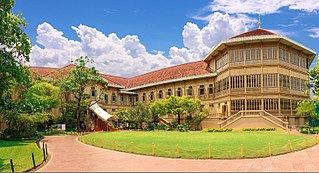
The Vimanmek Mansion is a former royal villa in Bangkok, Thailand. It is in the Dusit Palace complex in Dusit District. As of 2019 it has been dismantled to allow for foundation repairs and will be rebuilt upon its completion.

Carpenter Gothic, also sometimes called Carpenter's Gothic or Rural Gothic, is a North American architectural style-designation for an application of Gothic Revival architectural detailing and picturesque massing applied to wooden structures built by house-carpenters. The abundance of North American timber and the carpenter-built vernacular architectures based upon it made a picturesque improvisation upon Gothic a natural evolution. Carpenter Gothic improvises upon features that were carved in stone in authentic Gothic architecture, whether original or in more scholarly revival styles; however, in the absence of the restraining influence of genuine Gothic structures, the style was freed to improvise and emphasize charm and quaintness rather than fidelity to received models. The genre received its impetus from the publication by Alexander Jackson Davis of Rural Residences and from detailed plans and elevations in publications by Andrew Jackson Downing.
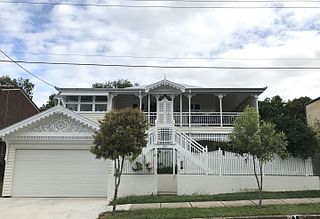
Australian residential architectural styles have evolved significantly over time, from the early days of structures made from relatively cheap and imported corrugated iron to more sophisticated styles borrowed from other countries, such as the California bungalow from the United States, the Georgian style from Europe and Northern America, and the Victorian style from the United Kingdom. A common feature of the Australian home is the use of fencing in front gardens, also common in both the United Kingdom and the United States.
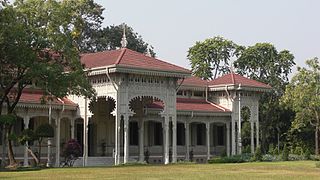
Abhisek Dusit Throne Hall or the Thai Handicraft Museum is a Throne Hall located within Dusit Palace to use as a throne hall and banquet facilities for Dusit Palace. Its construction started in 1903 and completed in 1904 in the reign of King Chulalongkorn. Architectural design by Mario Tamagno. Currently it use for a museum about Thai Handicraft in Bangkok, Thailand.

Queen Anne style architecture was one of a number of popular Victorian architectural styles that emerged in the United States during the period from roughly 1880 to 1910. Popular there during this time, it followed the Second Empire and Stick styles and preceded the Richardsonian Romanesque and Shingle styles. Sub-movements of Queen Anne include the Eastlake movement.

Folk Victorian is an architectural style employed for some homes in the United States and Europe between 1870 and 1910, though isolated examples continued to be built well into the 1930s. Folk Victorian homes are relatively plain in their construction but embellished with decorative trim. Folk Victorian is a subset of Victorian architecture. It differentiates itself from other subsets of Victorian architecture by being less elaborate and having more regular floor plans. Examples include the Bacon Hotel, Albert Spencer Wilcox Beach House, Lost Creek Baltimore and Ohio Railroad Depot (1892), James B. Carden House (1885), Ephriam M. Baynard House, and Sibley's General Store (1899) in the Sibley's and James Store Historic District.

Den Chai station is a railway station located in Den Chai Subdistrict, Den Chai District, Phrae. It is a Class 1 railway station and is the main station for Phrae Province, as there is no rail service to Phrae City. It is located about 530 kilometres (330 mi) from Bangkok railway station. It is also the station to alight for passengers heading to Nan Province.

In the New World, Queen Anne Revival was a historicist architectural style of the late 19th and early 20th centuries. It was popular in the United States, Canada, Australia, and other countries. In Australia, it is also called Federation architecture.

The Heimatstil is an architectural style of the second half of the nineteenth century and the first half of the twentieth referring to the historicist tendencies which one encounters in the German-speaking countries, including Switzerland, but also in Victorian England and even in the north and eastern parts of France, as well as Belgium and Flanders. The Heimatstil is characterized by the use of wood on the façade and sculpted beams, connected by protruding or rusticated stone, recalling the illustrations from literature and folklore, especially Germanic ones, from the time period.

The Embassy of France in Bangkok is the chief diplomatic mission of France in Thailand, and one of the oldest in the country. It was established as a consulate in its current location on the Chao Phraya River off Charoen Krung Road in Bangkok's Bang Rak District in 1857, following the signing of the Treaty of Friendship and Commerce which re-established diplomatic relations between the two countries the previous year. The mission was elevated to a legation in 1892 and an embassy in 1949, and supports the ambassador in promoting political, economic and cultural ties between the two countries.








